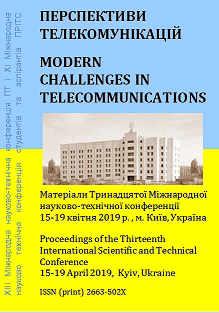УМОВИ ЗАСТОСУВАННЯ РОЗПОДІЛЕНИХ РАМАНІВСЬКИХ ПІДСИЛЮВАЧІВ В ФОТОННИХ ЛІНІЙНИХ ТРАКТАХ
Ключові слова:
РАМАНІВСЬКИЙ ПІДСИЛЮВАЧ, ФОТОННИЙ ТРАКТАнотація
Terms of use Distributed Raman Amplifier in Photon Line Path
The principle of Distributed Raman Amplifier (DRA) is analyzed.
The diagrams of levels of multiplex signals are described and illustrate.
В роботі проаналізовано принцип роботи Розподільчого Раманівського Підсилювача. Діаграми рівня сигналів проілюстровані та описані.
Посилання
Скляров О.К. Волоконно-оптические сети и системы связи. Москва, Солон-Пресс, 2004, 272 с.
Хмелёв К.Ф. Основы фотонного транспорта. Київ, Техніка, 2008, 680 с.
Макаров Н.С. Оптические волоконные усилители информационных сигналов. Научно-технический вестник Санкт-Петербургского университета информационных технологий, механики и оптики. Выпуск
Информационные, вычислительные и управляющие системы. СПб: СПбУИТМО (ТУ), 2002, с. 191…199.
Бердников О.М. Умови визначення потужності лазерів накачування раманівських розподільчих підсилювачів фотонних лінійних трактів. IX науково-практична конференція "Пріоритетні напрямки розвитку телекомунікаційних систем та мереж спеціального призначення. Застосування підрозділів, комплексів, засобів зв’язку та автоматизації в АТО" 25 листопада 2016 року (Тези доповідей). − Київ : ВІТІ, 2016. – С. 64.
##submission.downloads##
Як цитувати
Номер
Розділ
Ліцензія
Авторське право (c) 2019 Дмитро Олегович Огородник, Олег Михайлович Бердников

Ця робота ліцензується відповідно до Creative Commons Attribution 4.0 International License.
Authors who submit to this conference agree to the following terms:a) Authors retain copyright over their work, while allowing the conference to place this unpublished work under a Creative Commons Attribution License, which allows others to freely access, use, and share the work, with an acknowledgement of the work's authorship and its initial presentation at this conference.
b) Authors are able to waive the terms of the CC license and enter into separate, additional contractual arrangements for the non-exclusive distribution and subsequent publication of this work (e.g., publish a revised version in a journal, post it to an institutional repository or publish it in a book), with an acknowledgement of its initial presentation at this conference.
c) In addition, authors are encouraged to post and share their work online (e.g., in institutional repositories or on their website) at any point before and after the conference.

